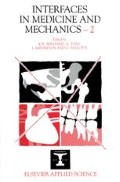Abstract
The use of Finite Element Modeling (FEM) is a valuable tool in the field of orthopaedic implants. In the present projects we emphasized the use of geometrically realistic models and easy understandable results to improve the dialogue with the orthopaedists. We built up models of femurs with and without prosthesis. The bone geometry and material properties were first obtained by dissection and literatur, later on by using a quantitative CT scanner (QCT). The implementation of an interface between QCT and pre/postprocessing program increased the speed of modeling a long bone dramatically. Bevore modeling an implant-bone system, the relative positioning of prosthesis and bone was determined by performing an implantation simulation with the help of solid modeling. Based on the use of three dimensional displays, the discussions with the surgeon during modeling and after the calculation enhance the understanding of the modeled system, as well as the interpretation of changes found in histologic examinations.
Access this chapter
Tax calculation will be finalised at checkout
Purchases are for personal use only
Preview
Unable to display preview. Download preview PDF.
References
Flemming, M., Scholten, Engelhardt, Kraftflussberechnungen in Knochenstrukturen und Prothesen, BMwF-1A 7a-7291 NTÖ 4, 1972.
Merz, B., Schenk, R.K., Wintermantel, E., Finite element model of a femur with a proximally fixed, cementless stem, Proceedings European Biomechanics. 7th Meeting ESB Aarhus, 1990.
Knauss, P., Materialkennwerte und Festigkeitsverhalten des spongiösen und kompakten Knochengewebes am coxalen Human-Femur, PhD Thesis, Universität Stuttgart, 1980.
Durand, E.P., Quantitative Analyse von Knochenstrukturen aus Computertomogrammen von gelenknahen Skelettabschnitten, PhD Thesis, Eidgenössische Technische Hochschule Zürich (ETH), 1989.
Müller A., Quantitative Computertomographie: Ein risikoarmes Verfahren zur Identifikation der osteoporosegefährdeten Frau, PhD. Thesis ETH 8102, 1986.
Galante, J., Rostoker, W., Ray, R.D., Physical properties of trabecular bone, Calcif. Tissues Res., 1970.
Carter, D.R., Hayes, W.C., The compressive behavior of bone as a two-phased porous structure, J. Bone Jt. Surg., 59A(7):954–962, 1977.
Carter, D.R., Spengler, D.M., Mechanical properties and composition of cortical bone, Clin. Orthop. 1978.
Gibson, L.J., The mechanical behavior of cancellous bone, J. Biomechanics. 18(5):317–328, 1985.
Rice, J.C., Cowin, S.C., Burr, D.B., On the dependence of the elasticity and strength of cancellous bone on apparent density, J. Biomechanics. 21(2):155–168, 1988.
Gibson, L.J., The mechanical behaviour of cancellous bone, J. Biomechanics. 18(5): 317–328, 1985.
Spotorno, L., Schenk, R.K., Dietschi, C., Romagnoli, S., Mumenthaler, A., Unsere Erfahrungen mit nicht-zementierten Prothesen, Orthopäde 16: 225–238, 1987.
Bentzen, S.M., Hvid, I., Jörgensen, J., Mechanical strength of tibial trabecular bone evaluated by x-ray computed tomography, J. Biomechanics. 20(8):743–752, 1987.
Keyak, J.H., Meagher, J.M., Skinner, H.B., Mote, C.D., Three-dimensional Finite Element Modeling of a proximal femur from CT scan data, Trans. Orthopaedic Research Society (35), p. 492, 1989.
Author information
Authors and Affiliations
Editor information
Editors and Affiliations
Rights and permissions
Copyright information
© 1991 Elsevier Science Publishers Ltd
About this chapter
Cite this chapter
Merz, B., Müller, R., Rüegsegger, P. (1991). Solid Modeling and Finite Element Modeling of Bones and Implant-Bone Systems. In: Williams, K.R., Toni, A., Middleton, J., Pallotti, G. (eds) Interfaces in Medicine and Mechanics—2. Springer, Dordrecht. https://doi.org/10.1007/978-94-011-3852-9_33
Download citation
DOI: https://doi.org/10.1007/978-94-011-3852-9_33
Publisher Name: Springer, Dordrecht
Print ISBN: 978-1-85166-583-9
Online ISBN: 978-94-011-3852-9
eBook Packages: Springer Book Archive

